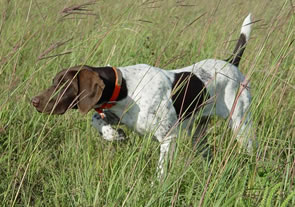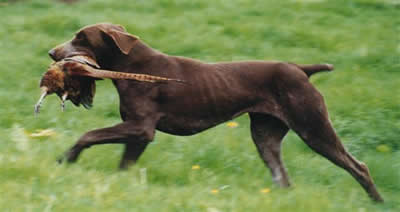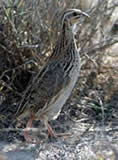Home » The Gundog Bible » French Tests
French tests and dizzied birds!
Country writer Jeremy Hobson visits a French working test and puts a game bird to sleep!!
 In France, all pure-bred puppies receive a three generation pedigree at the time of sale. To receive a full five generation pedigree and also to be eligible for registration with the Société Centrale Canine - the French equivalent of the Kennel Club - any working gundog must be assessed by an official confirmateur appointed by the SCC before it can be graded as either 'excellent', 'very good' or 'good'. Once this has been completed, its subsequent rating will dictate its desirability as a breeding bitch or stud dog, as well as its future eligibility for working tests and field trials.
In France, all pure-bred puppies receive a three generation pedigree at the time of sale. To receive a full five generation pedigree and also to be eligible for registration with the Société Centrale Canine - the French equivalent of the Kennel Club - any working gundog must be assessed by an official confirmateur appointed by the SCC before it can be graded as either 'excellent', 'very good' or 'good'. Once this has been completed, its subsequent rating will dictate its desirability as a breeding bitch or stud dog, as well as its future eligibility for working tests and field trials.
Some time ago, my wife and I were invited to an open working test for hunt/point/retrieve breeds and as a result, spent a glorious afternoon watching some lovely-looking young dogs as they competed over a mixture of stubble and flat water meadows.
Each group of dogs had their own designated area over which to hunt, but even so, the contestants that had been drawn last in their particular group had the added problem of foiled scenting from the dogs and handlers that had run earlier.
In a French working test of this nature, the dogs are expected to hunt up to a 'dizzied' quail and then hold a strong point until the judge kicks up the bird and a blank firing pistol is shot. From what we were told by our hosts, the judge is looking for hunting drive and passion, a proper point, no fear of gunshot and a lack of aggressiveness towards people or other dogs. Steadiness to flush is not expected at this stage.
Having watched several similar tests in the UK, it was immediately apparent that there is a significant difference in the training methods between France and Great Britain - whereas in the UK, all gundog handlers tend to introduce discipline and control early in a puppy's life, the French try not to curtail their dog's natural ability. Whether or not the examples my wife and I watched were accurate representatives of this philosophy, it did appear that the particular dogs we saw had a tendency to ignore all commands whether whistled or shouted, and seemed on occasions to hunt purely for themselves.

Most dogs found a bird within a reasonable time span although there did not appear to be a limit imposed and, even though some dogs that failed to quarter up to their quarry were eventually asked to withdraw, most eventually pointed, even if they did not hold the point for long. Some were almost on top of the bird when they did so, but we noticed that several only got to about a yard from the quail before coming up on point. Almost every dog chased the bird for some distance when it was kicked up, and some even caught them, in contrast to pointing breeds in the UK which seem, from my admittedly very limited experience, to be steadier in their quartering; more under their handler's control and hold the point for a longer period of time.
In a trance
 I don't know who it was who first discovered the practice of 'dizzying' quail - or any other type of game bird for that matter - nor what were there reasons for doing so, but it can be quite useful when training all types of gundog and I was shown how to 'dizzy' a bird by my old head-keeper, himself a well-known trainer and trialler.
I don't know who it was who first discovered the practice of 'dizzying' quail - or any other type of game bird for that matter - nor what were there reasons for doing so, but it can be quite useful when training all types of gundog and I was shown how to 'dizzy' a bird by my old head-keeper, himself a well-known trainer and trialler.
The basic method is to place the bird's head under its wing; cradle its body in both hands and gently rock your hands back and forth. In a very short space of time the bird appears to be in a trance and it can be gently laid on the ground where it will remain quietly until being 'kicked' up by the handler, at which stage they suddenly come back to 'normal' and fly off - it is, I suppose, a little like being put into a trance and, as well as putting this trick to practical use when dog training, have used it to amuse my children when they were small.